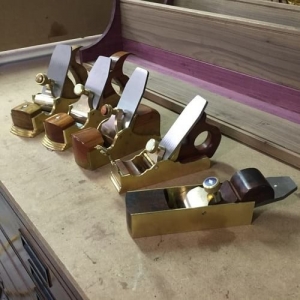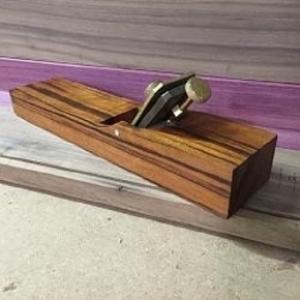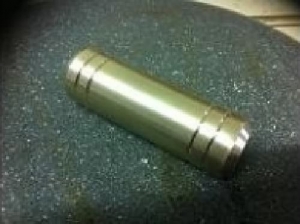Here is my family of Shop-built Hand Planes. Each one was hand-crafted by me from brass and exotic hardwoods. That is, scratch-built; no kit was involved.
Attachment 9173
From left to right we have a roughing smoother (designed to remove wood quickly), then a fine smoothing plane that gives a quality finish. Next a high-angled polishing smoother, 60 degree pitch (This plane can produce the finest of shavings. A painter/decorator friend of mine observed that he would not be able to get the same finish as this plane can get, with sandpaper). It works a bit like a scraper plane; it's really cool! Next comes an old-style smoothing plane with oak-leaf front, designed for small works (This little plane is a delight to use) and finally a low-angled mitre plane.
Here is a rear/side view of the set.
Attachment 9174
Most of my planing needs are catered for with this set of planes, except perhaps chamfering. But Look!
Here is an adjustable Japanese style champhering plane I made a few years ago which covers that problem:
Attachment 9175 Attachment 9176
Oddly, this is the only plane in the entire set that has an adjuster; the rest are hammer-adjusted. I moved away from Norris style adjusters a few years ago after reading Ron Brese's theories on adjusters. Now, any plane I make is hammer adjusted. There is a certain skill in hammer adjusting but it is learned quickly, and once mastered the finest adjustments can be made by the deftest touch of the hammer. It's fun to do as well.
I use either a small conventional type hammer or my preferred, palm-hammer, which slips easily into my shop-apron pocket and is therefore, always at hand. I find the palm hammer gives me greater control over the hammer tap than a handled hammer. This is the palm hammer:
Attachment 9177
It's a ridiculously simple little tool but as we often discover, the simplest solution to a problem is sometimes the best. I hold the palm hammer between by first finger and thumb and either tap the top of the blade to advance the blade, or tap the heel of the plane to retract the blade. Occasionally I might tap the side of the blade to straighten it up. You can set the blade for as fine a cut as you can and then tap the heel repeatedly, to get finer and finer shavings. Its amazing how fine you can actually go. You wouldn't have thought it was possible to do this with a hammer.
There is real satisfaction and an exquisite pleasure in constructing projects using tools that you have made yourself by your own hand. Words cannot describe that feeling. You have to immerse yourself in it to appreciate it.
A SHORT VIDEO ON HOW TO ADJUST HAND PLANES SUCH AS MINE
CAN NOW BE VIEWED ON MY BLOG.
Click on the link below.


 LinkBack URL
LinkBack URL About LinkBacks
About LinkBacks


 Reply With Quote
Reply With Quote







Bookmarks